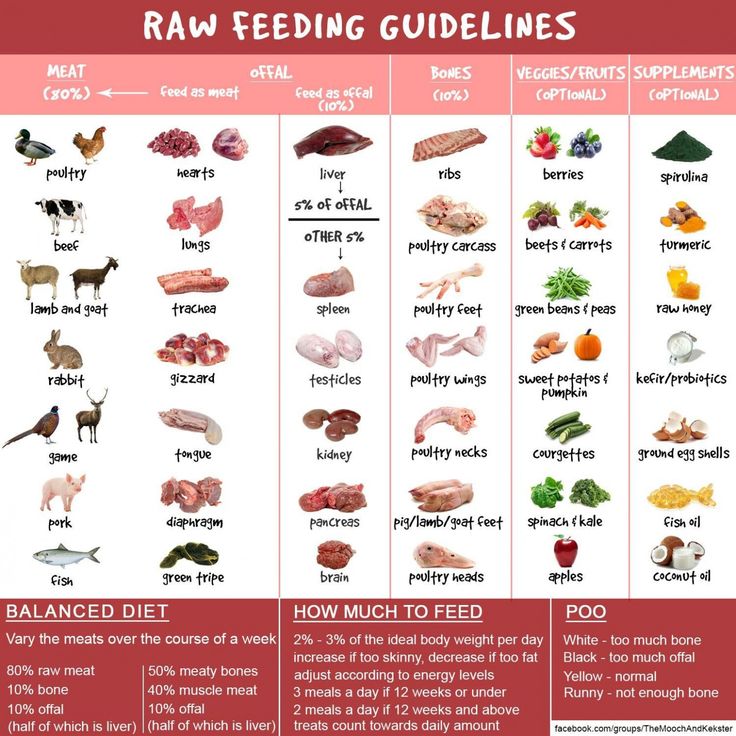When to feed baby meats
What You Want to Know
Being in charge of your baby’s nutritional needs can seem overwhelming because the choices are endless, from nutritional content and preparation, to color, taste, and texture.
Should you start by offering your baby applesauce or cereal, or can you start with meat? What’s the scoop on meat, anyway?
For most babies, breast milk or formula will give your baby all the nutrients, vitamins, and minerals that they need for the first 6 months of their lives.
If you’re exclusively or primarily breastfeeding, your doctor may suggest supplements for iron and vitamin D. According to the American Academy of Pediatrics (AAP), you’ll want to introduce vitamin D supplements from just about birth and iron after around 4 months. (Formulas are usually fortified with these already.)
Once you hit the 6-month milestone, you can start offering your baby solid food. Traditionally, parents have offered their babies cereal, veggies, fruit and then meat.
But is that the right approach? Maybe not.
Here’s why: At 4 to 6 months of age, the iron stores that your baby was born with are starting to get depleted. Iron is needed for hemoglobin formation and oxygen transport.
You can keep these iron levels high by introducing your baby to foods that are rich in iron. Iron comes in two forms: heme and non-heme iron.
- Heme iron. You’ll find this in red meat, seafood, and poultry. Heme iron is pretty easy for your body to absorb.
- Non-heme iron. You’ll find this in iron-fortified infant cereals, tofu, beans, lentils, and green, leafy veggies.
Heme iron is the easiest for your body to absorb. Which is exactly why you may want to start offering your baby meat as one of their first foods. In addition lean red meat also has zinc, vitamin B12, fats, and of course, lots of protein.
Is my baby ready?
You bet! If your baby has developed physically to the point that they’re now ready to handle the intricacies of eating solids, then they’re ready for eating meat.
Notice that their tongue thrust reflex is fading — they don’t push food out of their mouth with their tongue. They’ve learned to coordinate breathing and swallowing. They can sit in a high chair. They have good head and neck control.
Okay, so you’ve made the decision to offer meat to your baby. Now which meat is best for baby?
Beef, veal, lamb, mutton, goat, pork, chicken, or turkey? Organ meat such as heart, kidney, liver? What about buffalo meat? Yup, that counts as a meat source too.
The long and short is that all meats are good. But there are a couple of things to keep in mind.
Good to know:
- Liver is a significant source of iron, with pork liver delivering the highest amount
- Choose dark turkey meat over white. The dark meat contains 1.4 mg of iron per 100 grams compared to 0.7 mg per 100 grams in the white meat.
- Chicken liver has almost double the amount of iron that is found in beef liver.
- Light canned tuna in water offers 1.
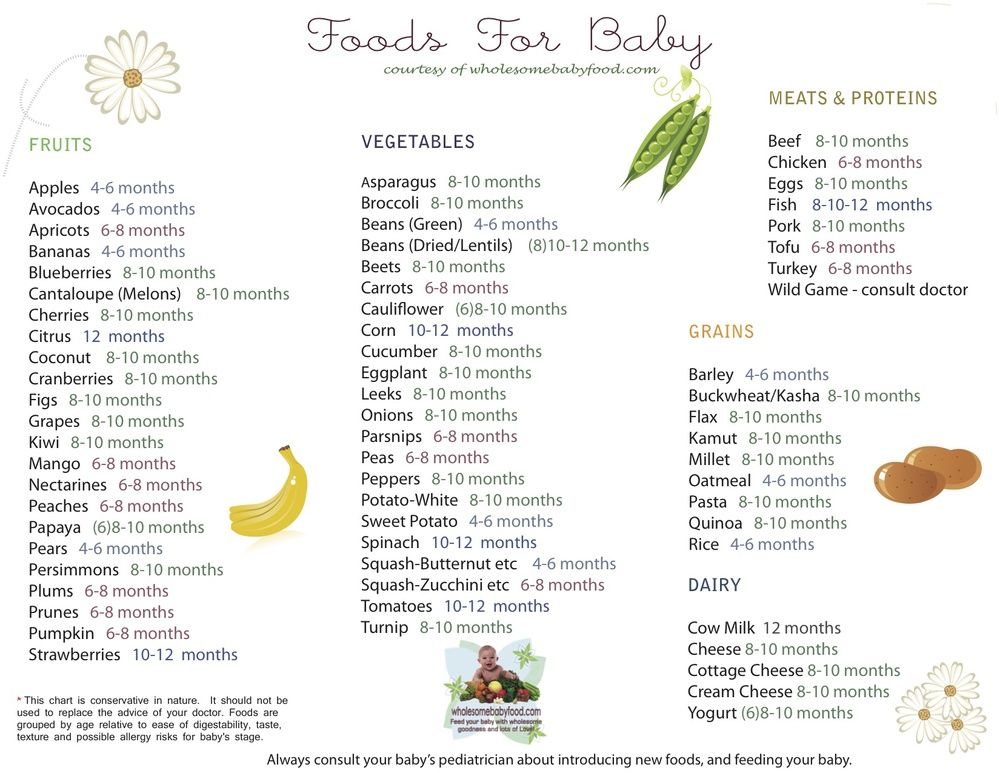 67 mg of iron per 100 grams.
67 mg of iron per 100 grams.
Do and don’ts:
- Do make sure that your baby eats fully cooked meat only. No “rare” or “medium rare” for little tummies.
- Do keep away from deli meats, bacon, and hot dogs. Not only are these meats packed with preservatives and chemicals, the average hot dog contains only 5.7 percent actual meat, according to a 2008 analysis.
- Do avoid fish that is high in mercury. Fish that’s approved by the FDA for kids is canned light tuna. (Note: The FDA says a serving for a 2-year-old is just 1 ounce, so up to 3 ounces of tuna weekly is recommended for toddlers.)
- Don’t fry meat for babies.
- Don’t reheat meat more than once.
What’s the best way to go about introducing meat to your baby? Every new stage in life is a learning curve, and we’ve got you covered whether you opt for jarred baby food or homemade food.
Jarred baby food
No doubt about it: This is your easiest option. Gerber and Plum Organics are two popular options you’ll find at your local grocery store. Meat may come as a standalone option, or as part of a blend with veggies or fruits. When introducing a food the first time, single ingredient foods should be used.
Meat may come as a standalone option, or as part of a blend with veggies or fruits. When introducing a food the first time, single ingredient foods should be used.
Remember that some brands of baby food include meat only at their stage 2 or 3 foods. If you want to introduce meat earlier, shop carefully or make your own baby food.
Homemade baby food
It’s not as daunting as it seems to make your own baby food. Make sure you’re armed with an immersion blender and you’ll be fine. Just for fun, have a look at our yummy recipes or consider buying a baby food cookbook. Or wing it on your own.
- Soups: Create a soup with your choice of meat and a mix of sweet potatoes, onions, carrots, and squash. Cook and then blend to smooth.
- Baking or roasting: While cooking this way preserves most of the nutrients in food, it’s a little harder to blend food that has been baked or roasted. You can thin out the mixture by adding water, formula, or breast milk.

- Slow-cooker: Using a slow-cooker might be the simplest way to prepare soft and well-cooked meats. Combine meats, veggies, and fruits to taste.
If you don’t feel like cooking a separate dish, don’t despair: Cooking for your baby can be as easy as scooping off part of your own supper. There’s a lot of fun in this. Set aside part of your meal and blend or mash.
Baby-led weaning
Want to skip the puree? Then baby-led weaning is for you. More and more busy parents are opting to let their 6-month-old babies feed themselves finger foods.
Baby-led weaning isn’t just good for parents. By feeding themselves, babies practice hand-eye coordination and fine motor skills. They also learn to self-regulate —they stop eating when they’re full. But do remember to check the meat you offer to remove bones and skin.
Good food choices for baby-led weaning:
- finger-long strips of meat
- kebabs and meatballs shaped into a finger-sized log instead of a ball.

- drumsticks
- lamb chops
Remember it’s important to closely supervise when your baby is eating and avoid foods with a shape, size, or texture likely to cause choking. Discuss any questions or concerns you have with your pediatrician.
Safety first!
No matter how you offer meat to your baby, make sure to cook it at these minimum temperatures:
- beef, veal, and lamb: 170°F (77°C)
- pork: 160˚F (71˚C)
- ground meat: 160˚F (71˚C)
- poultry pieces and ground poultry: 165˚F (74˚C)
- whole poultry: 180˚F (82˚C)
- fish with fins: 145˚F (63˚C)
Good to know:
- Your baby won’t eat more than a spoonful or two to start with. So feel free to freeze portions in ice cube trays. Move on to larger portions as their appetite increases.
- Potatoes don’t freeze well, so don’t throw them into your mixture if you’re planning on freezing part of it.
- Make sure to offer your baby a variety of meats to expose them to different flavors and textures.

- Anything left over? Remember to refrigerate leftovers within 2 hours.
No, you don’t need to give your baby meat. The American Dietetic Association acknowledges that “well-planned vegetarian diets are appropriate for individuals during all stages of the life cycle, including pregnancy, lactation, infancy, childhood, and adolescence, and for athletes.”
If you choose not to give your baby meats, you should offer them plenty of iron-fortified infant cereals, tofu, beans, lentils and green, leafy veggies. These contain non-heme iron.
It’s harder for your body to absorb non-heme iron, but you can increase the body’s absorption rate by pairing foods that contain non-heme iron with foods that contain vitamin C. Think beans served with tomatoes and cereal served with orange juice.
Good practice is discuss your plans with your baby’s healthcare provider and consider whether to opt for a blood test for your baby so that you can check their iron levels.
Bon appétit! You’re now at the stage when you and your baby can sit down at the table and enjoy a meal together.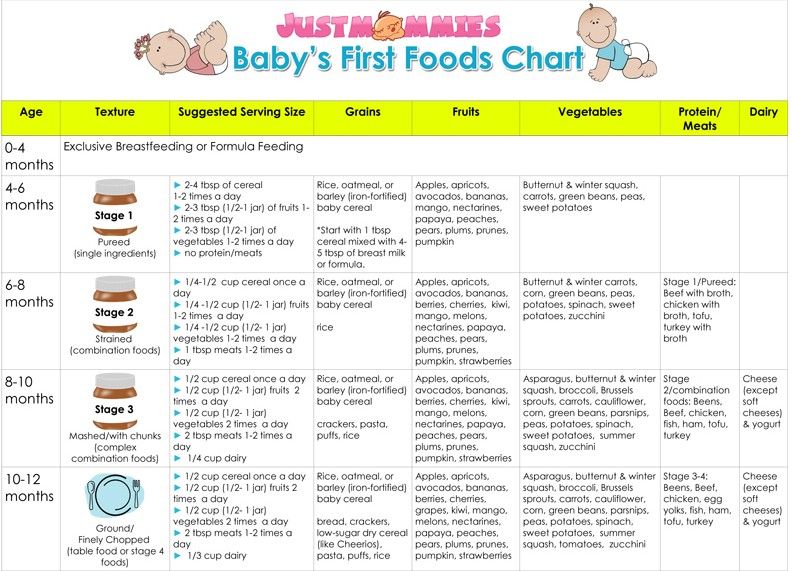 It won’t be long before they’ll join you in the kitchen and help you prepare it!
It won’t be long before they’ll join you in the kitchen and help you prepare it!
When Can Babies Have Meat? Introducing Meat to Your Baby’s Diet – Serenity Kids
For the first six months of your baby’s life, all of their nutrition comes from either breast milk, formula, or a combination of both. While you were probably excited and anxiously waiting for your little one to show signs that they are ready to begin solids, you may be feeling a little overwhelmed now that they are finally ready.
You may find yourself wondering what their first foods should be and when you can offer them certain foods, like meat. Although meat may seem a little intimidating at first, it’s packed with complete protein, vitamins, antioxidants, and key nutrients that are crucial for your baby’s growth—and it’s actually easier for your baby to digest than any other food group.
In this article, we'll explore the nutritious benefits of feeding your baby meat, tips for introducing it to your baby, how to prepare it according to their age, and the potential risks associated with feeding it to your baby. We'll also provide delicious, baby-friendly meat recipes and discuss meat alternatives.
We'll also provide delicious, baby-friendly meat recipes and discuss meat alternatives.
While meat is generally included in a healthy, well-balanced diet, it’s especially important for babies as they grow. Foods like pasture-raised beef, turkey, chicken, pork, and fish are some of the best sources for bioavailable vitamins and nutrients, such as zinc and iron, which help strengthen their immune system and reinforce brain development. Meat is recognized as one of the most nutrient-dense foods on the planet, making it an ideal choice when Every Bite Counts®.
Meat is also the best source of high-quality protein, which plays an essential role in many bodily functions. It helps provide the body with energy, repair tissues, and develop organs properly — all of which are crucial for your baby’s growing body.
Is it healthy to give meat to a baby?Once your baby is at least six months of age and has demonstrated the five main signs of readiness to begin eating solids, meat is a nutritious and delicious option for most babies. Because breastmilk is technically an animal product, a baby’s tummy contains all the enzymes necessary to digest meat and other animal products. In fact, they can digest animal products better than any other food group.
Because breastmilk is technically an animal product, a baby’s tummy contains all the enzymes necessary to digest meat and other animal products. In fact, they can digest animal products better than any other food group.
While the specific nutrition will vary depending on the type of meat you choose, offering your little one a variety of meats is a great way to incorporate different nutrients into your baby’s diet, while also taking advantage of the flavor window.
How can you choose and store meat for your baby?In most cases, your baby should be able to eat most kinds of meat right off the bat. Introducing them to different types of meat will also offer a wider range of vitamins and nutrients. We recommend choosing high-quality, ethically sourced meat from regenerative agriculture whenever possible. (Fun fact: three of our meat purees are even Land to Market verified!)
Common meat options include:
- Chicken
- Pork
- Beef
- Goat
- Turkey
- Bison
- Fish
Your baby can also eat other types of meats, such as organ meats.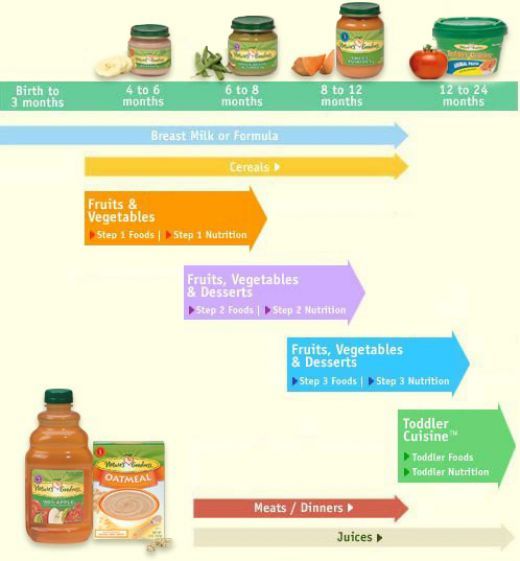 Some common organ meats include:
Some common organ meats include:
- Liver, which is rich in vitamin A, folic acid, iron, and zinc (Check out our article on How to Make Liver Bone Broth, which is a great way to get your baby some extra nutrients)
- Heart, which is rich in iron, zinc, selenium, and folate
- Kidney, which contains omega 3 fatty acids
Although most babies can eat all types of meat, preparation and storage are important to ensure the safety of your little one. For example, purees, ground meat, and meatballs can be stored in the refrigerator for 1-2 days. On the other hand, meat strips, shredded meat, and meat on the bone will generally stay fresh 3-4 days.
What to avoid when introducing meat into a baby's diet?Although you should aim to introduce your baby to a wide range of meats, there are several precautions that you should take to ensure your baby’s safety.
- Limit deli meats, hot dogs, and fried meats until 12 months.
 These processed meats are generally higher in preservatives and sodium.
These processed meats are generally higher in preservatives and sodium. - Avoid reheating meat more than once, when possible. Cooling and reheating food more than once can increase the potential for bacteria growth.
- Limit consumption of fish that are high in mercury, such as swordfish and king mackerel
- Ensure that you always give your baby fully cooked meat until 12+ months. This means the meat should reach a specified internal temperature, typically ranging from 145-165°F as designated by the FDA, based on the type of meat. It also shouldn’t be rare or medium-rare until 12+ months
Once your baby has turned six months old and has met the five signs of readiness for starting solids, meat is a great food to use as the basis of their solid food diet. Meat tends to be coarser than many other foods, so you may have to slightly alter how you prepare it, based on the age of your child.
Experts generally suggest preparing purees or pre-chewing meat for younger babies, while shredded, ground, and cubed meats are usually acceptable for older babies and toddlers. This will help ensure that your child is getting the nutritious benefits of meat, regardless of their age.
Pre-chewing (called premastication) may sound gross and might not be for every parent, but is an excellent way to share the meat you're eating with your baby. In fact, the enzymes in your mouth actually aid in its digestion.
It’s important to pay attention to your child’s current development, such as how well they are able to chew, when deciding how to introduce meat into their diet.
How can you prepare healthy, delicious meat for a baby according to age?While we love the Baby-Led Introduction to Solids (BLISS) method, which combines both purees and baby-led weaning, you may choose to follow a more traditional approach when you prepare meat for your baby.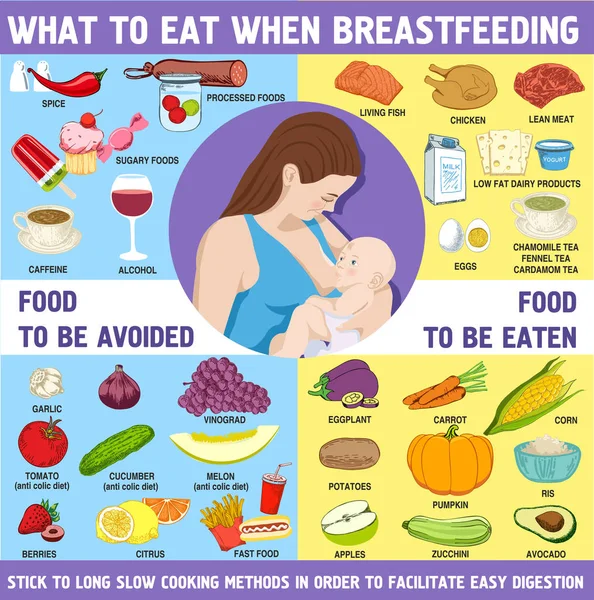 This generally consists of starting with purees and working up to small pieces of food as they get older and better at chewing.
This generally consists of starting with purees and working up to small pieces of food as they get older and better at chewing.
To learn more about the BLISS method of introducing solids, visit our article on Introducing Solids: Why We Love Both Baby-Led Weaning and Purees.
Meat for a 6-old-month babyPurees are a great option for many parents who don’t feel ready to give their baby coarser textures or meat prepared in other ways. Not only is there less risk of choking with purees, it may be easier to provide more nutrients and flavors to their diet.
Simply cook your chosen meat and puree it in a blender or food processor until it’s a smooth consistency. Add water or breast milk to thin as needed. You may find that your baby does better with thinner purees to start, but quickly learns to handle thicker consistencies.
If you don’t have time to make it yourself or aren’t interested in premastication, Serenity Kids Ethically Sourced Meats Variety Pack and Bone Broth Variety Pack are convenient and nutritious options for babies who aren’t quite ready to handle shredded or smaller cut meat.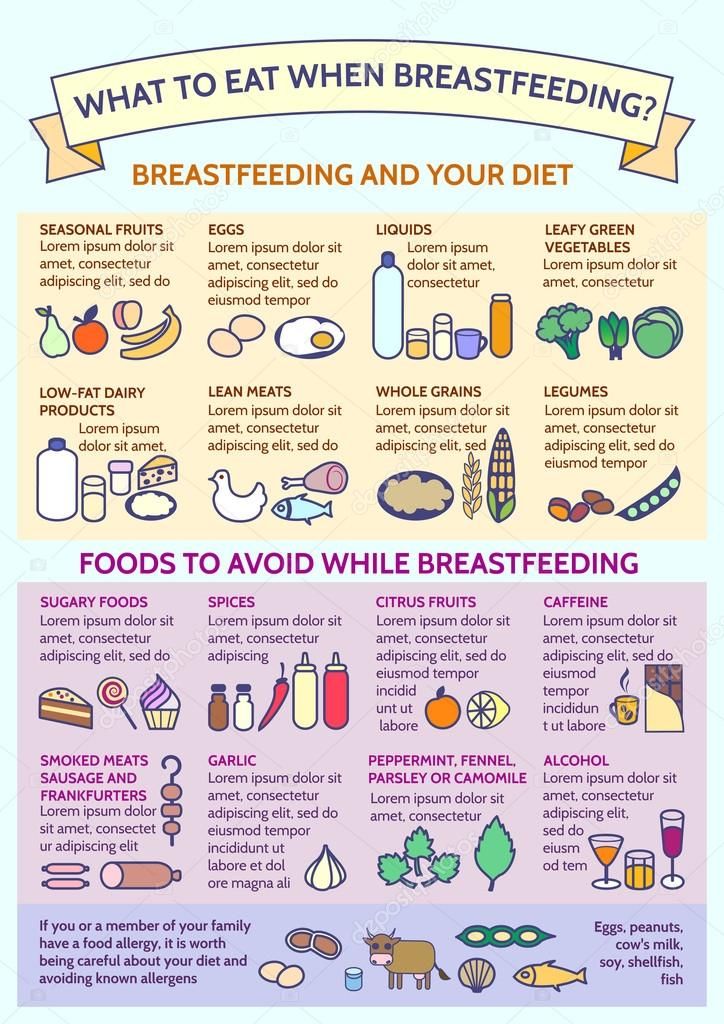
As your baby gets older, they’ll be able to better handle chewing and digesting larger, solid pieces of food. This is a great time to begin giving your baby finger foods, like shredded or thinly sliced meat.
This will also help develop their motor skills, like the pincer grasp, as they learn to pick up food and bring it to their mouth. To learn more about the pincer grasp, visit our article one What is the pincer grasp and when do babies develop it.
Meat for toddlersOnce your child has shown that they can safely handle shredded meats, you can begin giving them smaller pieces of meat, like ground chicken or beef. By this time, their pincer grasp should be well-developed, making it easier for your little one to pick up the smaller pieces of finger food. They also likely have teeth coming through that will help chew up these smaller bite sized pieces.
Delicious meat recipes that will satisfy your baby’s palateWhile babies can often just eat a version of whatever you’re having for dinner, here are some delicious meal ideas to help encourage your baby to eat meat.
Pork contains the fatty acids EPA and DHA, which are critical for normal brain development and function.
This homemade baby food recipe uses uncured bacon, ground pork, butternut squash, and spinach to provide your little one with a boost of vitamin D and vitamin E.
Visit our Homemade Bacon Baby Food Recipe.
Savory toddler pancakesThis recipe incorporates our 100% Grass-Fed Bison Food Pouch with Organic Kabocha Squash & Spinach with egg, ricotta cheese, and vegetables.
Visit our Savory Pancakes recipe.
Toddler-Approved Beef & BroccoliWe love that this recipe literally takes ten minutes or less (while still packing in balanced nutrition thanks to nutrient-dense ingredients).
This recipe incorporates our Beef Puree; check out the step-by-step process here.
Meatballs with mashed potatoThis simple recipe combines ground beef with mashed potato to make a delicious meal for your baby. You could also opt for sweet potatoes or add herbs to give your baby a taste of different flavors, as well as added nutritional benefits.
You could also opt for sweet potatoes or add herbs to give your baby a taste of different flavors, as well as added nutritional benefits.
For extra flavor and a boost of protein and amino acids, use our Turkey Bolognese with Bone Broth puree as a sauce for your meatballs. You could also use tomato sauce or season with mild chili powder for a different flavor.
Visit this Baby Meatballs Recipe.
Can meat be a hazard for a baby?Like any other food, there are potential risks when it comes to incorporating meat into your child’s diet.
Can meat choke your baby?Meat tends to be coarser and harder to chew than some of the softer foods. With that, meat could be a choking hazard if not prepared correctly, which is why you shouldn’t offer small cuts of meat to your baby before they are ready.
Feeding your baby foods that are prepared and cut age-appropriately will greatly reduce their risk for choking — although it won’t ever remove the risk completely. It’s also important to always put your child in a safe eating position and to keep a close eye on them while they are eating.
It’s also important to always put your child in a safe eating position and to keep a close eye on them while they are eating.
Although food allergies are relatively common, meat allergies are extremely rare. In some cases, however, parents find that their child may have an allergic reaction to certain meats.
Common symptoms of a food allergy include:
- Hives or skin reaction
- Itching
- Sneezing
- Wheezing or trouble breathing
- Nausea, vomiting, or diarrhea
For parents concerned about allergies, it’s a common practice to introduce one food at a time in case your baby reacts to something they’ve eaten. This can help you identify possible food allergies.
When to get medical advice?If your baby is showing any signs of an allergic reaction to something they’ve eaten, it’s important to consult a healthcare professional immediately. They will help treat your child and determine the underlying cause of the reaction.
They may recommend a skin prick allergy test, followed by blood work to identify specific allergens that may be affecting your little one. We aren’t health professionals so we always advise you to consult with yours.
So what’s the bottom line?Starting your baby on solids can be a little nerve-racking, between navigating which foods are best and how to prepare them. Fortunately, babies can eat nearly everything that adults can eat, including meat. Not only is meat a nutritious option, there are many different ways to prepare it, making it an ideal first food for babies.
And for when you need an easy option for busy nights or days spent on-the-go, Serenity Kids has a variety of ethically-sourced meat purees ready to be enjoyed by your little one.
Written by Jennifer Wirth. Jennifer is a professional health writer, leveraging her scientific background as a Chemical Engineer to uncover the most interesting aspects of infant nutrition, pregnancy, and parenting. As a wife and mother of three young children, Jennifer is passionate about providing the best possible nutrition for her family. She believes that developing healthy eating habits early helps build the foundation for a long, fulfilling life.
As a wife and mother of three young children, Jennifer is passionate about providing the best possible nutrition for her family. She believes that developing healthy eating habits early helps build the foundation for a long, fulfilling life.
when and how much meat to give, how to enter
correctlyPublished: 07.10.2019
Reading time: 4 min.
Number of reads: 77580
Meat plays an important role in feeding a child: it contains a large amount of protein, and is also the main source of iron, which contributes to normal growth and development. Its absence in the diet can lead to anemia and rickets. In order for the products to be well absorbed, you need to choose the right time to introduce complementary foods and the right type of meat. The diet of an infant and a child over 1 year old should be balanced, so you should also not forget about cereals, vegetables and fruits - they are no less important for the baby's health. nine0003
Content: Hide
- From what age can I give meat
- Useful properties
- Can meat be harmful
- The main rules
- Differences in varieties
- A few important issues
- What meat is not given?
- How to calculate the amount of meat?
- How often to add meat to the children's menu?
- Benefits of mashed potatoes
At what age can meat be given
Complementary feeding usually begins at 4–6 months of age.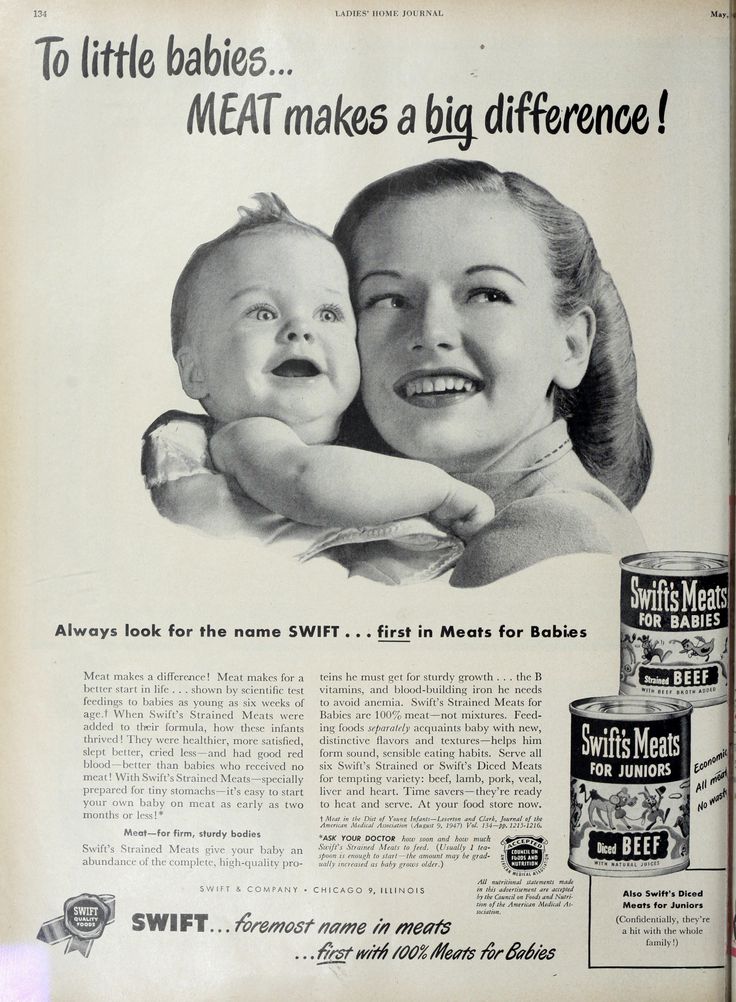 The timing is relevant for both IV and breastfeeding children. This takes into account the individual characteristics of the baby and his readiness to perceive new food. The preferred age for introducing complementary foods into a healthy baby's diet is 5 months. In any case, the very first product on the baby’s menu is not meat, but porridge or vegetable puree. Only after the body has adapted to them, it will be possible to further expand the diet. Do not forget that each child is individual, so nutritional habits may vary. However, 6 months is taken as the average age when meat is introduced to a child. There are canned meat (raw meat 40–65%), meat and vegetable (10–20%) and vegetable-based with meat (less than 10%). Meatballs are also produced. nine0003
The timing is relevant for both IV and breastfeeding children. This takes into account the individual characteristics of the baby and his readiness to perceive new food. The preferred age for introducing complementary foods into a healthy baby's diet is 5 months. In any case, the very first product on the baby’s menu is not meat, but porridge or vegetable puree. Only after the body has adapted to them, it will be possible to further expand the diet. Do not forget that each child is individual, so nutritional habits may vary. However, 6 months is taken as the average age when meat is introduced to a child. There are canned meat (raw meat 40–65%), meat and vegetable (10–20%) and vegetable-based with meat (less than 10%). Meatballs are also produced. nine0003
According to the "National program for optimizing the feeding of children in the first year of life in the Russian Federation", meat complementary foods should be prescribed no later than six months. Meat in the baby's complementary foods should appear after the introduction of cereals (porridge) and vegetable dishes. Meat supplements are especially needed for children who tend to develop iron deficiency anemia.
Meat supplements are especially needed for children who tend to develop iron deficiency anemia.
Benefits
The start of complementary foods should not be too early, when the body is not yet ready for such food. This can lead to disorders and allergies. However, with timely introduction to the diet, the product will be very useful:
- is a source of protein that is essential for growth and is used as a building material in the body. The protein content in canned meat for children (mashed beef, rabbit meat, poultry (chickens, turkey), lamb, etc.) is 8–10%;
- is a product rich in micro and macro elements (iron, magnesium, zinc), as well as vitamins B₁, B₂, B₆ and B₁₂;
- contains a rich set of amino acids that can only be obtained from food;
- Heme iron found in meat is absorbed faster than the same element from plant products; nine0016
- fibrous structure helps to develop chewing skills faster.
Can Meat Be Harmful
Some types of meat cause allergic reactions, and in large quantities this product puts a strain on the kidneys. It is also worth following certain recommendations when choosing, for example, giving low-fat varieties. The guide to baby food, edited by V. Tutelyan and I. Kon, suggests introducing meat at 9 months. It is best to use quail, rabbit, turkey, chicken for this. How well a particular type of meat is digested can be determined by the consistency of the stool. In case of any problems, symptoms from the gastrointestinal tract may occur: increased gas formation, bloating, discomfort. nine0003
It is also worth following certain recommendations when choosing, for example, giving low-fat varieties. The guide to baby food, edited by V. Tutelyan and I. Kon, suggests introducing meat at 9 months. It is best to use quail, rabbit, turkey, chicken for this. How well a particular type of meat is digested can be determined by the consistency of the stool. In case of any problems, symptoms from the gastrointestinal tract may occur: increased gas formation, bloating, discomfort. nine0003
Basic rules
Keep order. At least two weeks must pass between the appearance of new products in the diet, regardless of whether it is meat or something else. The child should gradually get used to previously unfamiliar food and adapt. However, if he does not eat what is offered, do not give up and try to do it again. It can take 7-10 days to form a habit.
Feed small meals. It is recommended to start with 5 g and gradually increase the amount to the age norm (in 6 months, the norm of commercially produced meat puree is 5-30 g). You can mix meat puree with vegetables that are already well known to the baby, or dilute with breast milk. Also make sure that the consistency of the food is not thick, but not too liquid. nine0003
You can mix meat puree with vegetables that are already well known to the baby, or dilute with breast milk. Also make sure that the consistency of the food is not thick, but not too liquid. nine0003
Watch your reaction carefully. It is better to give new foods in the morning to make sure they are absorbed properly. If the child develops redness or other signs of allergy, you should consult a doctor. After the negative effects have passed, you can try in two weeks to offer a different type of meat.
Do not use spices. Salt, pepper or other seasonings should not be present in the food, as they create an unnecessary burden on the pancreas and kidneys. A small amount of vegetable oil is allowed. If you buy ready-made puree, be sure to pay attention to the composition. nine0003
Read also: Learning to live with taste
Variety differences
Not all mothers know what meat to start complementary foods with. In some cases, it is worth considering the individual characteristics of the organism. If the child is prone to allergic reactions from the skin or intestines, then it is better to choose turkey or rabbit meat. Children who cannot digest cow's milk proteins should not be given veal and beef. When the child has already become acquainted with different types of meat, you need to alternate them in the diet - this helps to avoid allergic manifestations and makes the menu more varied. Each meat product has its own characteristics:
If the child is prone to allergic reactions from the skin or intestines, then it is better to choose turkey or rabbit meat. Children who cannot digest cow's milk proteins should not be given veal and beef. When the child has already become acquainted with different types of meat, you need to alternate them in the diet - this helps to avoid allergic manifestations and makes the menu more varied. Each meat product has its own characteristics:
- rabbit meat. Has a higher concentration of iron, phosphorus and B vitamins than other varieties. Well absorbed in most cases, less calories;
- turkey. Contains phosphorus, calcium, iron, vitamins of groups A and B. Improves appetite, has a positive effect on the cardiovascular system;
- veal. Contains carotene, phosphorus, magnesium, potassium. These substances help strengthen bones and muscles; nine0016
- chicken. Tender and rich in amino acids meat, but it often causes allergies, so it is better to introduce it with caution.

Some important questions
What kind of meat not to give?
Pork is not the best option due to its high fat content, it should be introduced later than other types. The meat of geese and ducks contains refractory fats that the digestive system cannot cope with yet. These varieties up to 3 years old should not be included in the diet. nine0131
How often should meat be added to the children's menu?
How many times a week to give meat depends on the variety. Lean rabbit meat can be eaten every day, as well as veal, if you are not allergic to it. Chicken, turkey or pork should be limited to 2-3 times every 7 days.
Benefits of ready-to-eat purees
You don't have to make your own, baby food is available. This solution also has its advantages:
- mother will be able to devote more time to the baby, since she does not have to stand at the stove, because the puree from the jar just needs to be warmed up; nine0016
- products are labeled according to the degree of grinding, so you can find the right option for every age.
 There are homogenized, puree and ready-made dishes - meatballs or cutlets;
There are homogenized, puree and ready-made dishes - meatballs or cutlets; - meat can be combined with other healthy ingredients such as cereals or vegetables.
The production of baby food is subject to very strict requirements, so all processes are carefully controlled. You can also alternate options using ready-made and homemade puree. This is quite acceptable, it is important that the child receives the required amount of meat products. nine0003
#First food #Wood
Rate the article
(Number of votes: 18, average 5.0)
Share with friends:
Complementary meat: why, when and how
Reviewer Kovtun Tatyana Anatolievna nine0003
53621 views
October 21, 2021
Login or register to save articles and products as favorites
As your baby grows, so does his need for vitamins, minerals and other important nutrients. When to introduce meat into complementary foods for a child so that he gets the maximum benefit?
When to introduce meat into complementary foods for a child so that he gets the maximum benefit?
Meat is a source of complete animal protein. It contains essential amino acids, vitamins and minerals. Their deficiency in the nutrition of the child can lead to serious consequences, in particular to developmental delays and health problems. nine0003
One of the valuable minerals in the composition of meat is iron, which is very important for development. Iron is part of the structure of the heme protein, which delivers oxygen to the cells and tissues of the body. In addition, the iron contained in meat is very well absorbed.
Meat purees are an essential part of a child's daily diet.
Why should meat purees be included in a child's daily diet?
- For growth. nine0012 Meat contains a complete animal protein - a source of essential amino acids that are necessary for building your own cells and tissues.
- To deliver oxygen to tissues.
 Iron, which is found in meat, is necessary for the process of hematopoiesis and oxygen delivery to cells and tissues.
Iron, which is found in meat, is necessary for the process of hematopoiesis and oxygen delivery to cells and tissues. - For proper metabolism. Vitamins B2 and B6, as well as zinc, are essential for proper metabolism.
So at what age can you give a child meat and how to do it? nine0003
When to introduce meat into complementary foods
This question is best answered by a pediatrician who has been observing the baby from birth, because the question of at what age it is possible to give meat to a child is decided individually, taking into account the characteristics of the child. The only general rule is that meat complementary foods should be introduced no earlier than 6 months. Up to a year, meat should be given to the child daily.
What kind of meat to start complementary foods with
It is best to start with monocomponent meat purees of industrial production - those that contain only one type of meat. So, if the baby has a negative reaction, it will immediately be clear what it is. To minimize the risks of allergies, it is better to choose low-allergenic meat purees. nine0003
To minimize the risks of allergies, it is better to choose low-allergenic meat purees. nine0003
FrutoNanny has a special line "First Choice"* where you can find hypoallergenic rabbit and turkey purees**. To begin with, it is worth treating the crumbs with 1/2 teaspoon of mashed potatoes in the morning and bring the amount to the age norm within 7-10 days.
How to introduce meat - is it worth cooking it yourself or is it better to use ready-made purees?
It is difficult for mothers and fathers to determine the amount of nutrients and harmful substances in products for a baby without special devices. In addition, at home it is difficult to ensure complete microbiological safety, the required degree of grinding of the product. nine0003
The baby food industry handles these tasks very well. This is facilitated by verified technology:
- Products are tested to meet quality standards. Specialists make sure that dangerous microorganisms, nitrates, pesticides and heavy metals do not get into the jars.

- Foods are nutritionally balanced. The baby will receive the right amount of nutrients, regardless of the time of year. nine0016
- In production, it is possible to make puree with an ideal homogeneous texture. Puree is easy, tasty and safe to eat - it does not contain large pieces that will be superfluous for a baby who does not yet have enough teeth to chew solid food.
The kid wants to give all the best, so the excitement of parents is understandable: you need to choose the safest, most delicious and high-quality product. With ready-made mashed potatoes, parents can be calm about the diet of their boys and girls when it becomes possible to give the child meat. FrutoNyanya has developed meat purees that will help children grow up big, strong and healthy. nine0003
FrutoNyanya meat purees are:
- 100% natural, without artificial additives, preservatives, dyes, GMOs.
- Meat only, water and some rice flour for consistency, no starch or salt added.

- Selected raw materials only from domestic suppliers.
- Uncompromising quality control at all stages of production.
- Wide range, including purees with clinically proven low immunogenicity and hypoallergenicity** - "Rabbit" and "Turkey"
- Delicious puree with delicate texture
In the production of meat purees in glass jars, there is always a space above the product where a vacuum is created to ensure tightness. The oxygen present in this space interacts with the myoglobin protein found in the meat. Therefore, the top layer of puree darkens.
In the manufacture of canned meat in tin containers, packaging takes place without creating a vacuum, so there is no oxygen in the can, and the top layer does not change color. nine0003
Myoglobin is absolutely safe for health. It is not necessary to remove the darkened layer of puree, the puree can simply be mixed and heated.
Glass jars are convenient, environmentally friendly and do not emit any hazardous substances.
Tips on how to start meat complementary foods
When parents have decided how many months they can give their child meat, you should act according to the following algorithm:
- Consult a pediatrician. nine0016
- Prepare dishes. The child should receive complementary foods from separate dishes intended for young children.
- Select the feeding time. When introducing a new complementary food, offer it during the second morning feeding - this way you can observe the reaction of the baby to the new food during the day.
- Start with a small amount, such as 3-5 grams or half a teaspoon. During the week, it is necessary to gradually increase the portion until it corresponds to the age norm. nine0016
- Do not combine several new products at once. The kid will not benefit from such a variety.
FrutoNanny is constantly evolving to better meet the needs of all its little customers. Therefore, when choosing which meat to introduce into complementary foods first, pay attention to the entire line of products.








